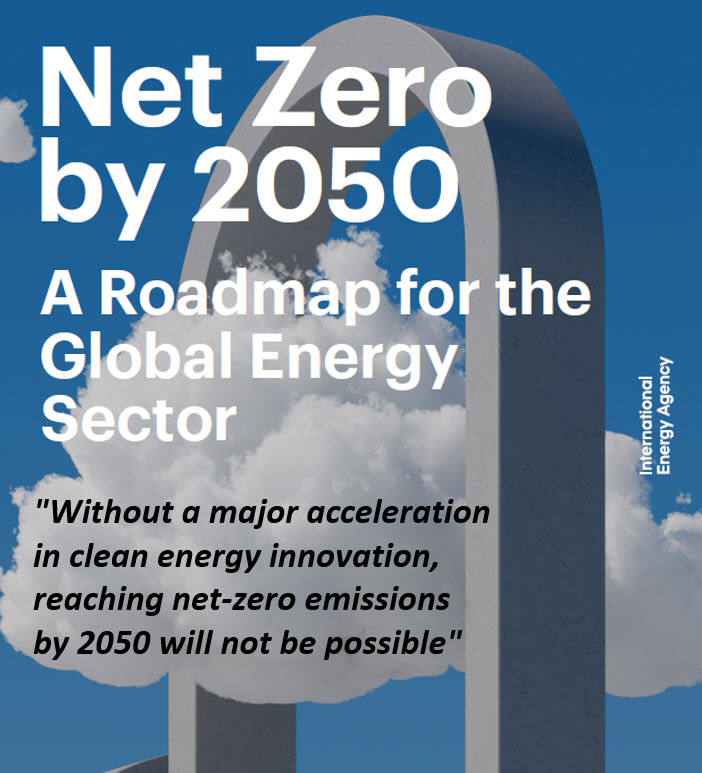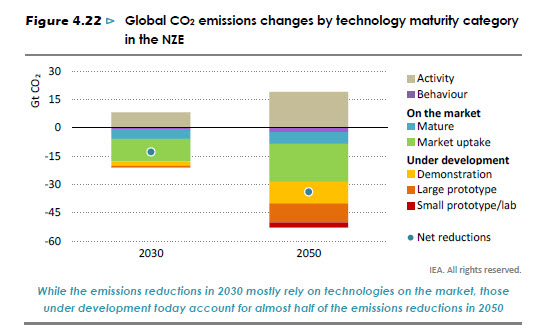
“Without a major acceleration in clean energy innovation, reaching net-zero emissions by 2050 will not be possible.”
A groundbreaking report, “Net-Zero by 2050: a roadmap for the global energy system“(referred to as NZE here) by the Internation Energy Agency (IEA), has been emphasising that this decade is pivotal to reaching net-zero by mid-century.
This 2050 target is in line with the 2015 Paris Agreement, the foundations of global consensus to limit the rise in global temperature to 1.5c. This requires nothing short of a total transformation of the energy systems.
The report is the world’s first comprehensive study of how to transition to a net-zero energy system by 2050 while ensuring stable and affordable energy supplies, providing universal energy access, and enabling robust economic growth.
The report sets out a cost-effective and economically productive pathway, resulting in a clean, dynamic and resilient energy economy dominated by renewables like solar and wind instead of fossil fuels. The report also examines key uncertainties, such as the roles of bioenergy, carbon capture and behavioural changes in reaching net zero.
The role of innovation has a crucial one to play.
In the near term, the report describes a net-zero pathway that requires the immediate and massive deployment of all available clean and efficient energy technologies, combined with a major global push to accelerate innovation.
To quote from this IEA view :
- Most of the global reductions in CO2 emissions between now and 2030 in the net-zero pathway come from technologies readily available today.
- But in 2050, almost half the reductions come from technologies currently only at the demonstration or prototype phase today.
This realization and reality demand that all global governments quickly increase and reprioritise their spending on research and development and demonstrate and deploy clean energy technologies – putting them at the core of energy and climate policy. Progress in advanced batteries, electrolysers for hydrogen, and direct air capture and storage can be particularly impactful.
The report emphasises that the energy transition required is of such scale and speed it cannot be achieved without sustained support and equally significant engagement and participation from citizens, whose lives will be affected in multiple ways.
The IEA also highlights the ratcheting up of global ambitions, both by leading governments, financial institutions and corporates.
To quantify the needs of this energy transition.
Total annual energy investment surges to USD 5 trillion by 2030 in the net-zero pathway, adding an extra 0.4 percentage points a year to global GDP growth, based on a joint analysis with the International Monetary Fund.
Within this decade, the needs of innovation have to focus on finding solutions that deliver energy efficiency, renewable energy, electrification of everything, electric vehicles (EVs) and reduced both carbon and methane emissions. Innovation has a critical role in delivering new solutions to drive this energy transition we are undergoing.
The IEA models that RD&D investment needs to treble to US$90bn annually vs current levels. For advanced batteries, this pathway to commercialisation is being funded by capital markets. For others like CCS and hydrogen, serious investment rather than talk is required.
Beyond 2030, the IEA notes that technology breakthroughs might allow advanced batteries, hydrogen (particularly via heavy industry demand precincts), bioenergy, CCS and/or direct air capture and storage to each play a role if research, development and deployment (RD&D) is invested in at scale.
The report also points outs from a known innovation perspective that the actions, investments and deployment required by 2030 will be predominantly driven by technologies known and in operation today, the IEA models that 55% of cumulative emissions reductions will come from initiatives linked to consumer choices, assisted by enabling policy frameworks, e.g. moving to EVs, retrofitting housing with energy efficiency technologies and installing heat-pumps to clean cooking.
What does this all mean for innovation?
In the IEA opinion, they believe and understand that technologies available on the market today provide nearly all the emission reductions required by 2030 in the Net-Zero plan to put the world on track for net-zero emissions by 2050.
However, reaching net-zero emissions will require the widespread use after 2030 of technologies that are possibly unknown yet, or to be discovered, or are still under early development today. In 2050, almost 50% of CO2 emission reductions in the pathway to Net-Zero come from technologies currently only at the demonstration or prototype stage.

Now that is good news that we are moving the innovation needle, but it is the demonstration globally only point today in many possible solutions. We need a magnitude of multiple solution configurations and in a different application context in various regional and country contexts. Innovation needs to move out of the labs into commercial application pathways.
An acceleration of this magnitude in innovation discovery to commercial implementation is clearly ambitious.
A good point mentioned in this report was: The energy transition requires technologies that are not yet available on the market or are yet to be demonstrated at scale in multiple configurations and in various regional contexts, they are in prototype phases. In most cases, these demonstrations are run in parallel in the NZE. This is in stark contrast with the typical practice in technology development: learning is usually transferred across consecutive demonstration projects in different contexts to build confidence before widespread deployment commences.
In present-day reality, this doesn’t happen.
This parallel approach makes sense as long as global learning can be freely exchanged and built into final solutions to accelerate understanding and application. That is in direct conflict with present approaches of the commercial practice of IP and investment held by one party, not shared. We are facing this sharing dilemma in our present race to vaccinate the world.
The acceleration that is needed also requires a large increase in investment in demonstration projects. Most of these projects are concerned with the electrification of end‐uses, CCUS, hydrogen and sustainable bioenergy, mainly for long-distance transport and heavy industrial applications. Increased public funding helps to manage the risks of such first‐of‐a‐kind projects and to leverage private investment in research and development (R&D) in the NZE and needs greater collaboration with private investors to spread the risks.
The big innovation needs of the Energy Transition
In the NZE, electrification, CCUS, hydrogen and sustainable bioenergy account for nearly half of the cumulative emissions reductions to 2050. Just three technologies are critical in enabling around 15% of the cumulative emissions reductions in the NZE between 2030 and 2050: advanced high-energy-density batteries, hydrogen electrolysers and DAC.
Many of the biggest clean energy technology challenges could benefit from a more targeted
approach to speed up progress

Again, quoting the report: Bringing new energy technologies to market can often take several decades, but the imperative of reaching net‐zero emissions globally by 2050 means that progress has to be much faster. Experience has shown that the role of government is crucial in shortening the time needed to bring new technology to market and diffuse it widely (IEA, 2020i).
The government role includes educating people, funding R&D, providing networks for knowledge exchange, protecting intellectual property, using public procurement to boost deployment, helping companies innovate, investing in enabling infrastructure and setting regulatory frameworks for markets and finance.
Knowledge transfer from first‐mover countries can also help in the acceleration needed and is particularly important in the early phases of adoption when new technologies are typically not competitive with incumbent technologies.
The report uses examples of solar PV. National laboratories played a key role in the early development phase in the United States, projects supported directly by the government in Japan created market niches for initial deployment and government procurement and incentive policies in Germany, Italy, Spain, United States, China, Australia, and India fostered a global market.
Also, another example in the past has been Lithium‐ion (Li‐ion) batteries. These were initially developed through public and private research, mostly in Japan. Their first energy‐related commercial operation was made possible in the United States, and mass manufacturing today is primarily in China.
The scope of innovation required. A three horizon timeline.
To quote the report, the top-line innovation clean energy technology challenges to be resolved and outlines the different focal points and timelines.
- To 2030, government action focuses on bringing new zero‐ or low‐emissions technologies to market. For example, in the NZE, steel starts to be produced using low emissions hydrogen at the scale of a conventional steel plant, large ships start to be fuelled by low‐emissions ammonia, and electric trucks begin operating on solid-state batteries. In parallel, there is rapid acceleration in the deployment of low‐emissions technologies that are already available on the market but have not yet reached mass-market scale, bringing down the costs of manufacturing, construction, and operating such technologies learning‐by‐doing and economies of scale.
- From 2030 to 2040, technology advances are consolidated to scale up nascent low emissions technologies and expand clean energy infrastructure. Clean energy technologies that are in the laboratory or at the small prototype stage today become commercial. For example, fuels are replaced by electricity in cement kilns and steam crackers for high-value chemicals production.
- From 2040 to 2050, technologies at a very early stage of development today are adopted in promising niche markets. By 2050, clean energy technologies at the demonstration or large prototype stage become mainstream for purchases and new installations, and they compete with present conventional technologies in all regions. For example, ultra high-energy-density batteries are used in aircraft for short flights.
We can’t delay or wait for unproven scalable technology. We need to drive down emissions all the time.
What we cannot do is “bank “on technologies that we don’t have yet or not at any commercial proven point. Governments can’t delay the actions they are required to do pending a possible technology breakthrough fix.
We must recognize that there is no scope for new fossil fuel developments for the world is to get on the right and only trajectory of achieving the net-zero goal by 2050. Just think, no scope and what that means in Asia, in China, India, Japan, Australia or in the USA, rich in coal, oil and gas.
Carbon accumulates in the atmosphere takes years to dissipate, and simply waiting makes cutting carbon emissions even harder to achieve later down the road. I presently cannot buy into BioEnergy and CCUS concepts; these do not seem commercially feasible or capable of taking theory into scalable solutions and able to have global adoption.
We need to both deploy when a solution is proved and innovate where it needs to be validated. The innovation mantra needs to be “invent, invest and implement” globally and with ever-increasing speed.
Please view this groundbreaking report, “Net-Zero by 2050: a roadmap for the global energy system“, by the Internation Energy Agency (IEA). All visuals are taken from this report shown here.
1 thought on “Accelerating Clean Energy Innovation”
Comments are closed.